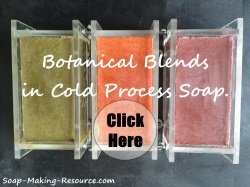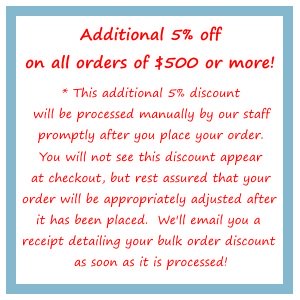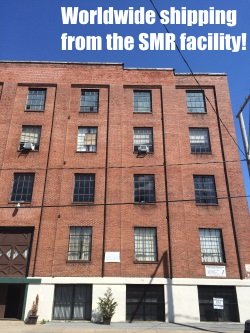SMR Ingredient Guide:
Beeswax in Soap Making
Did you know that beeswax in soap making can be used to add hardness to your finished product, create a soap bar that lasts longer in the shower and give your soap a unique look and feel? On this page I will be explaining how to use beeswax in soap making and share with you some interesting information about this important cosmetic and soap making ingredient.
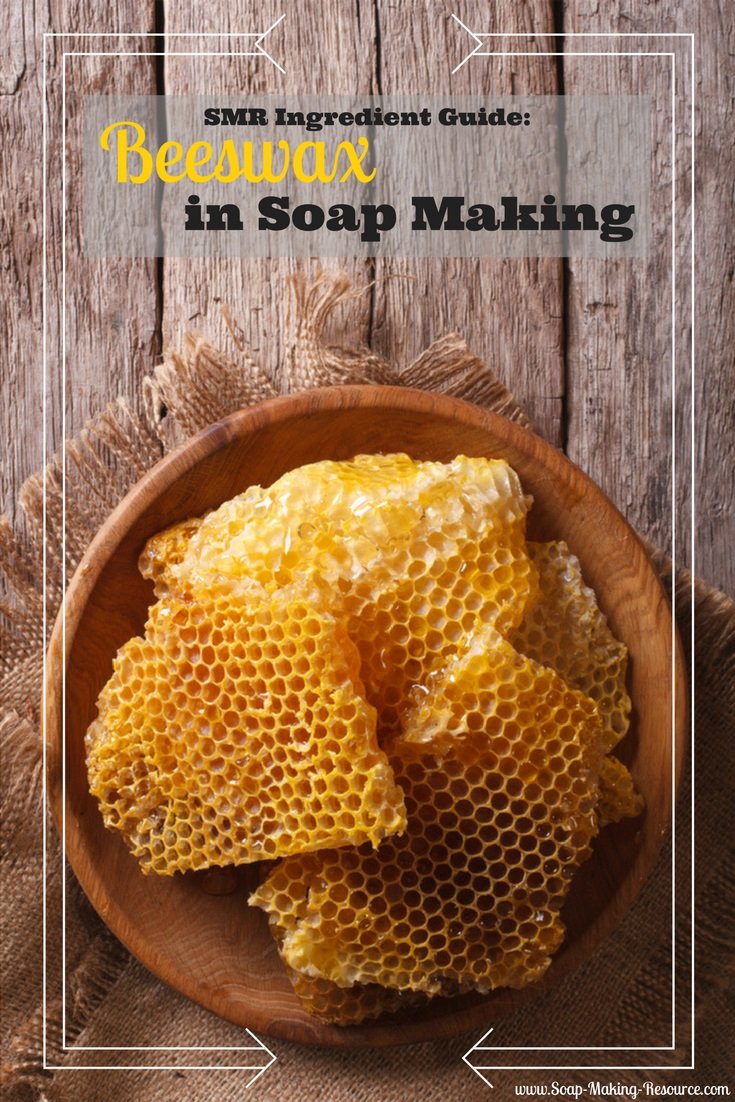
Yellow beeswax in pastille form is very easy to work with as you can simply pour or scoop out your necessary amount of yellow beeswax pastilles instead of trying to cut or shave your needed portion of beeswax off of a large beeswax block or have to melt your beeswax down every single time you need some for your recipe. Remember, beeswax is exceptionally hard, so it will be very difficult to cut. For most soap makers, it is important to buy beeswax in pastille form (sometimes referred to as pellet or granule form) for safety and ease of use. Click here to learn more about Soap Making Resource's yellow beeswax (pastilles) and to buy this quality ingredient from SMR.
Below is a picture of SMR's yellow beeswax (pastilles):
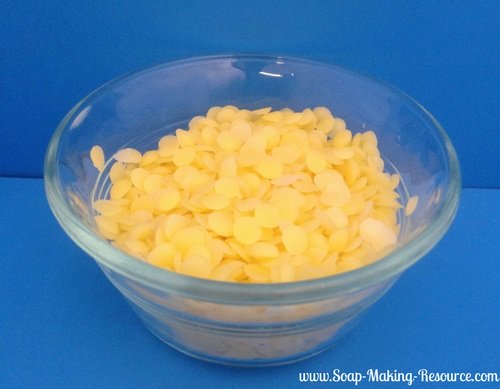
Usage Rates for Beeswax in Soap Making
So, exactly how much beeswax should you use in your recipe? Typically, beeswax is incorporated into a soap recipe at a 1% - 2% usage rate. So, for a batch of soap that makes 5 pounds of finished product, you would add 0.05 pounds (0.8 ounces) to 0.10 pounds (1.6 ounces) of yellow beeswax. Adding too much beeswax to your soap formula could cause your soap's lather production to decrease. This is most likely due to beeswax's high content of unsaponifiables. According to our research, many report that beeswax's unsaponifiable content is often around 50%. In other words, a large portion of beeswax will not turn into soap when it interacts with lye. Most soap makers want to avoid lather reduction as much as possible, so it is important not to go overboard when adding beeswax to your batch.
Furthermore, including too much beeswax in your formula may cause your finished product to be overly sticky. This is also something that we want to avoid. Again, just don't go overboard with this ingredient and you will have wonderful results that will highly benefit your product.
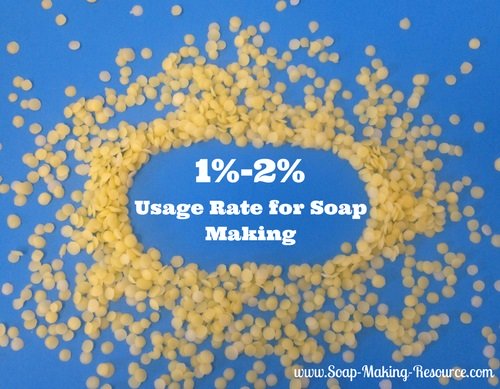
Click here to check out Soap Making Resource's Original Lotion Bar Recipe demonstrations.
Click here to check out Soap Making Resource's Mango Butter Lotion Bar Recipe demonstration.
Click here to check out Soap Making Resource's Emu Oil Lotion Bar Recipe demonstration.
We used SMR's yellow beeswax (pastilles) in all of these batches!
We also use yellow beeswax as a binder in our activated charcoal facial mask recipe!
Does Beeswax Saponify?
Yes. Beeswax does indeed saponify! The SAP value of yellow beeswax can range depending on its unsaponifiable content along with other factors. According to our research, different types of beeswax can have different SAP values. There are 2 major types of beeswax, Oriental beeswax (produced by the Oriental honey bee) and European beeswax (produced by the European honey bee). Although the primary components of these 2 types of beeswax are very similar, with only a small difference in overall composition, each type can have a different SAP value. Generally, however, yellow beeswax has an SAP value of about .067 according to soapcalc.net, a popular online lye calculating software for soap making. Yellow beeswax has a very similar SAP value to jojoba oil, which is also technically a wax.
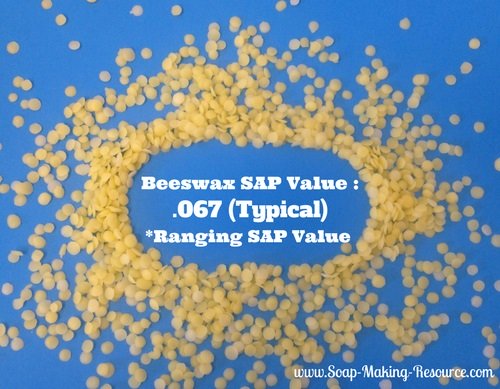
So, are you confused about what this ranging SAP value means for your soap batch? Click here to see some notes further down this page about the best way to incorporate beeswax into your batch with all the factors in mind. The ultimate solution really is very simple!
How to Incorporate Beeswax into your Soap Recipe
Incorporating beeswax into your soap recipe is very easy. You can integrate this ingredients into your soap recipe formula or you can simply include this ingredients as an additive (my recommended method) without calculating it as part of your oils/fats mixture. The latter option is a great choice if you want to add beeswax to one of your existing recipes without having to reformulate everything. Keep in mind, however, that if you are adding the beeswax as an additive, you really shouldn't use more than the recommended 1% - 2% usage rate since this ingredient won't be worked into your oil/lye formula.
How should you add yellow beeswax to your recipe as an additive? There is a very specific way that I recommend you incorporate this ingredient when it is not taking part in your soap formula. Unlike most additives and super-fat ingredients, you should avoid adding beeswax to your soap at trace. Due to beeswax's high melting point (approximately 140 degrees Fahrenheit), adding beeswax to your soap at trace may cause this ingredients to solidify prematurely, preventing it from integrating with all the other ingredients. Simply put, when your soap finally reaches trace, it may be just too cool to successfully incorporate the beeswax into the batch without the beeswax hardening. This can cause you to have clumps of beeswax throughout your finished product instead of the beeswax being evenly dispersed throughout the batch.
What's the solution? Simply melt your yellow beeswax portion into your soap making oils mixture and mix it in thoroughly.
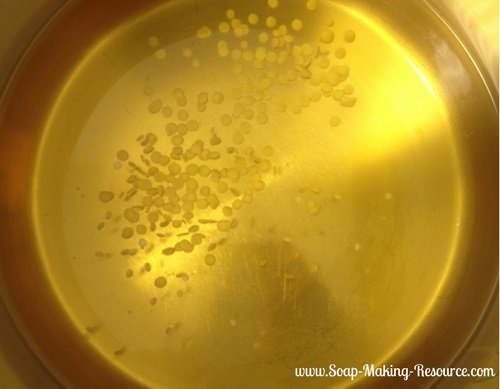
Adding the yellow beeswax during this stage, when you still have full control of your ingredient's temperature, will ensure that you can completely melt the beeswax down and integrate it with the other raw materials.
Remember, even though you are adding the yellow beeswax to your oils mixture, keep in mind that we are still considering it to be an additive as it is not worked into your oils/lye formula.
Adding yellow beeswax with this method will increase your finished product's super-fat percentage because no additional lye was added to saponify the extra partial fat portion that beeswax introduces to your batch. Just remember that because of beeswax's ranging SAP value, you won't know exactly how much your super-fat percentage will be increased. After all, yellow beeswax is not made up of 100% fat, so it will be nearly impossible (unless you have costly raw material analysis equipment!) to tell exactly how much extra fat yellow beeswax is adding to your batch! Yellow beeswax will also add valuable unsaponifiables to your finished product that may increase the skin nourishing qualities of your soap bar.
Now, if you decide to work your beeswax portion into the soap recipe formula instead of incorporating it as an additive, simply create your recipe using a soap calculator and calculate your new required lye amounts. Just remember that for this particular ingredient, as explained above, the SAP value can have a relatively wide range, so the actual lye amount needed for a recipe involving this ingredient can be difficult to calculate. If you are only using a small portion (like the recommended 1% - 2% usage rate) this shouldn't pose a major problem as long as you have a decently large super-fat percentage (5% or more!) built into your recipe as a cushion to cover any SAP value discrepancies.
Why would you incorporate beeswax into your formula instead of just incorporating it as an additive? Adding beeswax into your soap recipe formula may be advantageous if you already have a very high super-fat level (and you don't want to add any additional fat to your formula) or if you have other additives that are already being incorporated at trace (or to your melted oils like in the case of beeswax) that are not taking part in the actual oil/lye formula. You wouldn't want to dilute your finished soap bar too much with ingredients that don't go through the saponification reaction. After all, you want your final soap bar to be made up of actual soap, right? There is definitely a limit as to what percentage of additives and super-fat oils you can have in your batch before you start seeing negative qualities within your finished product like decreased lather, quick dissolving of your soap when exposed to H2O and an overly soft finished product.
What is my recommended "ultimate" way to add yellow beeswax to your batch? I highly recommend that you include the yellow beeswax as an additive to your oils mixture at a usage rate of 1% - 2% and mix your oils and lye solution at a higher temperature than normal. First of all, this incorporation method will allow you to disregard the ranging SAP value because the yellow beeswax will not be taking part in your oils/lye formula. It would be nice to not have to worry about beeswax's SAP value! Secondly, this yellow beeswax incorporation method will allow you to easily add this raw material to any existing soap formula with ease without having to recalculate your required lye amounts. This will make adding beeswax to your batch nice and simple! Thirdly, adding the yellow beeswax to your oils mixture, instead of at trace, will allow for the successful integration of your beeswax, without the unfortunate occurrence of your wax solidifying before it is fully mixed into your batch. Finally, combining your oil and lye solution at a higher temperature (try around 140 degrees Fahrenheit or a little lower if possible) will help prevent your beeswax from prematurely solidifying. With these factors in mind, in my opinion, incorporating your beeswax as an additive within your oil mixture and making your soap at an increased temperature is the best way to include this valuable raw material within your handmade soap product.
Try SMR's yellow beeswax (pastilles) in your next batch and see how you like! Don't forget to let us know about your results. You can click here to access our contact form now and let us know how you like what our yellow beeswax did for your product. We always appreciate your feedback!
What Properties will Yellow Beeswax add to Soap
Yellow beeswax will help promote a creamy lather in your handmade soap bar. On its own, beeswax will produce very few bubbles in your lather. Of course, with a well-balanced soap recipe formula that incorporates other important carrier oils, you can easily include beeswax at the recommended 1% - 2% usage rate (for its many benefits) and still produce a soap bar that has lots of bubbles. As you know, when formulating soap, it's all about creating a well-balanced recipe.
Below is a picture of our soap's lather from a soap bar that was produced with a formula that contained 2% of SMR's yellow beeswax (pastilles).
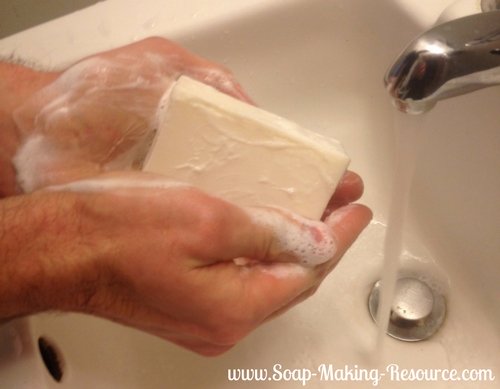
Yellow beeswax will also increase your soap bar's hardness. Creating a harder bar of soap has multiple benefits. For one, a hard bar of soap made with yellow beeswax is said to have a "longer life" in the shower. Many handmade soap bars are 100% all-natural and don't use any synthetic hardeners, so a lot of consumers feel that handmade soap has a tendency to "melt away" in the shower quicker than commercial soap bars. The inclusion of yellow beeswax into your handmade soap product could offer a real benefit to your consumer by preventing your soap from dissolving as quickly when it is exposed to water.
Also, a harder soap bar may be easier to remove from your mold. I can't make any guarantees for your particular formula, but in my experience, a harder bar of soap is easier to remove from a no-line mold like our acrylic log soap mold or acrylic slab soap mold. In fact, many soap makers add sodium lactate to their batch in order to produce a harder finished product and to aid in unmolding. Try SMR's yellow beeswax (pastilles) in your next batch instead and see how this works for you! Yellow beeswax may be a great alternative to sodium lactate!
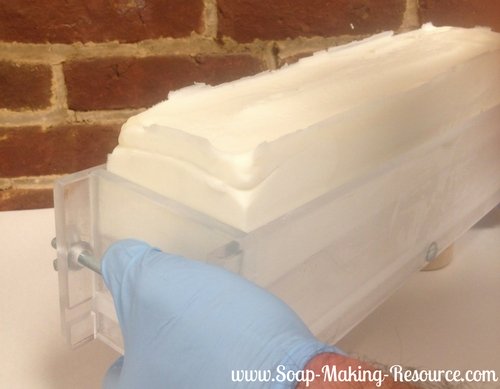
Finally, a harder bar of soap is less likely to become damaged during unmolding and storage. There is nothing more frustrating than producing beautiful handmade soap bars and then accidentally damaging them as you are handling your product. Have you ever had that beautiful (but soft) bar of soap that ended up getting fingerprint markings, or even nicks and dings all over it due to the handling of your product after it came out of the mold? I know I have when I first started out! Harder bars of soap are simply less prone to damage while you are handling your new creations.
|
Sign Up Today!
*Your information is SAFE with us! |
Finally, I would venture to say that most of your soap consumers simply prefer a harder bar of soap. After all, who doesn't like a high quality 100% all-natural handmade soap bar that is nice and hard? Everyone has different preferences, but I would guess that most people would prefer a harder bar of soap over a softer bar of soap. If you ever wondered how to make a hard bar of soap, yellow beeswax is a key ingredient, especially in the all-natural soap industry!
Remember, if you are selling your soaps at market, your customers will be picking them up, handling them, smelling them; and they will definitely be feeling your soap bar's texture! Everything counts when creating a product for your wonderful customers if you want to create a large base of loyal super-fans!
The Look, Feel and Aroma of Beeswax in Soap
Yellow beeswax in soap making will give a unique look and feel to your finished product and, in our experience, adds very little, if any aroma to your soap. Handmade soaps that incorporate yellow beeswax have a distinctive translucent gleam to them. They almost seem to glisten. It's like you're soap will have a new shininess and radiance!
Yellow beeswax in soap making will also impart a beautiful golden yellow hue to your finished soap bars. Yellow beeswax can actually be used as a natural soap colorant! The vibrancy of the color produced by yellow beeswax will depend on your yellow beeswax usage rate and your base oil formula. For instance, in our experience, a soap formula that is high in palm kernel oil will have a much brighter white color with only a very slight yellow sheen to it. Other base oil formulas may produce a finished product that is more "sensitive" to the color produced by yellow beeswax and consequently have a much deeper yellow hue. Experiment with SMR's yellow beeswax and see what colors you can produce in your product!
Below is a picture of our finished yellow beeswax soap. The picture hardly does it justice. You should check this thing out in real life to notice the subtle uniqueness of our beeswax soap's appearance!
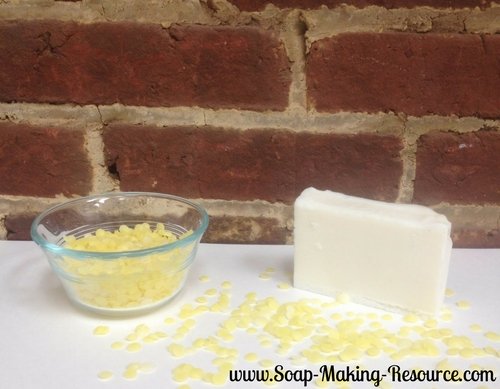
Yellow beeswax will also give your soap a unique "skin feel" that many consumers love! Try yellow beeswax in your soap sometime to notice the delicate alteration in your product's texture and the lovely feeling that your soap gives your skin when this ingredient is incorporated into your batch!
Finally, yellow beeswax imparts very little, if any aroma to your soap. If beeswax adds an aroma to your finished product when used at higher usage rates, the scent will most likely be very soft and subtle. When incorporating beeswax at just 1% - 2%, we've found the aroma to be pretty much non-existent. You may be able to just barely notice a very subtle sweet beeswax aroma in your product if you try really hard to pick it out. If it is there, it VERY subtle indeed! Furthermore, any beeswax scent, even if you are incorporating yellow beeswax at a higher usage rate, will most likely fade over time and it will probably fade very quickly.
I personally love the smell of yellow beeswax. It always brings me back to my childhood and making primitive beeswax candles at summer camp. Beeswax has such a wonderfully rich sweet aroma. I love getting to enjoy this fantastic scent as I work with beeswax before I add it to my batch!
Thank you all for checking out this SMR ingredient guide. We hope that this beeswax in soap making tutorial truly helps you. Remember, if you have any questions or comments, please feel free to contact us. We are more than happy to help you. That's what we're here for!
Don't forget to browse soap-making-resource.com for great soap recipes and a large selection of quality soap making supplies. Of course, you can even buy SMR's all natural yellow beeswax (pastilles) right here at www.soap-making-resource.com!
Enjoy using SMR's yellow beeswax (pastilles) in your next batch!
Return from beeswax in soap making to the main beeswax page.

